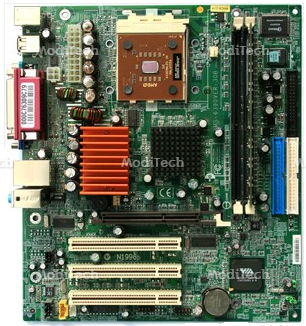Hardware and its Components
♢ Definition By ModiTech77: Hardware refers to the physical component of any computer's system that can be touch and feel. The tangible, visible, material parts of a computer or other system are known as hardware.
Hardware
The components or devices that are connected to a computer are collectively known as hardware. The function of these components is typically divided into three main categories: input, output, and storage. Components in these categories connect to microprocessors, specifically, the computer's central processing unit (CPU), the electronic circuitry that provides the computational ability and control of the computer, via wires or circuitry called a bus. Hardware may be classified into Central Processing Units (CPU) and the peripherals. The CPU entails Control Unit (CU), Arithmetic and Logic Unit (ALU), and the Internal Memory Unit (IMU) or main memory. For Example, monitor, mouse, keyboard, speaker, and printer come under the term hardware.
The hardware is the machinery itself. It is made up of the physical parts or devices of the computer system like the electronic Integrated Circuits (ICs), magnetic storage media, and other mechanical devices like input devices, output devices, etc. All these various hardware are linked together to form an effective functional unit. Computer hardware comprises an electronic component, such as a CPU and monitor. it also includes some electromechanical parts like keyboard, mouse, printer, scanner, disk drives, tape drives, loudspeakers for input, output, and storage.
Components of Hardware
♢ Motherboard:-
Motherboard is the main circuit board or main component of a computer. it is a printed circuit board that connects other components through the use of traces or electrical pathways. The motherboard is indispensable to the computer and provides the main computing capability. Personal computers normally have one central processing unit (CPU) on the motherboard. it includes processors(CPU), RAM, BIOS, CMOS, the disk drives (CD, DVD, hard disk, floppy, etc.) any other peripherals connected via the ports.

♢ Central Processing Unit (CPU):-
This is the main brain of the computer that accepts data, performs operations on the data, and sends out the result. Information from an input device or the memory of the computer is communicated via the bus to the Central Processing Unit (CPU), which is the part of the computer that translates commands and runs programs. It consists of ALU and CU, and a single chip or series of chips that perform arithmetic and logical calculations and controls the operations of the other elements of the system.

♢ Monitor:-
This is the Visual Display Unit (VDU). There are various technologies for the display unit, cathode ray tube (CRT) or Liquid Crystal Display (LCD) or electroluminescent screens, or the projector. The monitor or screen displays your work. Facing it down reduces reflected glare from room lights. This reflection may affect your sight.Monitorscome in different sizes. The (most important) size of the monitor is measured diagonally on the screen (in inches). Based on this, the monitors range in sizes of 12", 14", 15", 17", 19", 21", 29", etc. Monitors are also characterized by the flatness of their screens. The flatter and the wider screens are usually better.

♢ Keyboard:-
This is the Basic Input Device. It is one of the ways you can tell the computer what to do. It consists of the standard typewriter keys as well as a numeric keypad and function keys. You can use it to give the computer commands, name folders and files, and type text in word processing documents. The keyboard is made of three main categories of keys and each used for a different purpose.

♢ Mouse:-
This is another input device used to move a small white arrow pointer-the Cursor (but the shape will change depending on the context in which the mouse is being used) on the screen. By pointing and clicking you can carry out commands. The computer may ask you to verify that you are sure to rename a file, by clicking on the Ok button. Amouseis primarily made of three parts: the buttons, the handling area, and the sensor (rolling object or light). There are either one, two, or three mouse buttons. By default, a mouse has two buttons: left and right. Most mice nowadays are also equipped with a wheel on top of the middle button called the Scroll Button.

♢ Plotter:-
A PLOTTER consists of an arm that moves across the paper on which the diagram or graph needs to be drawn. A pen moves along the arm, and the arm itself moves relative to the paper. A combination of the two thus provides movement along the horizontal and vertical axes. A plotter can be connected to a PC through the parallel port. A plotter is more software-dependent than any other peripheral and needs much more instructions than the printer for producing output.

♢ Scanner:-
A scanner scans an image and transforms the image into ASCII codes that are used by acomputerto represent the characters you find on your keyboard, such as alphabets, numbers, punctuation marks, and graphics. These can be edited, manipulated, and printed.

You might like this :-
○ Generation of computer
○Type of computer
○Input device
○History of Computer